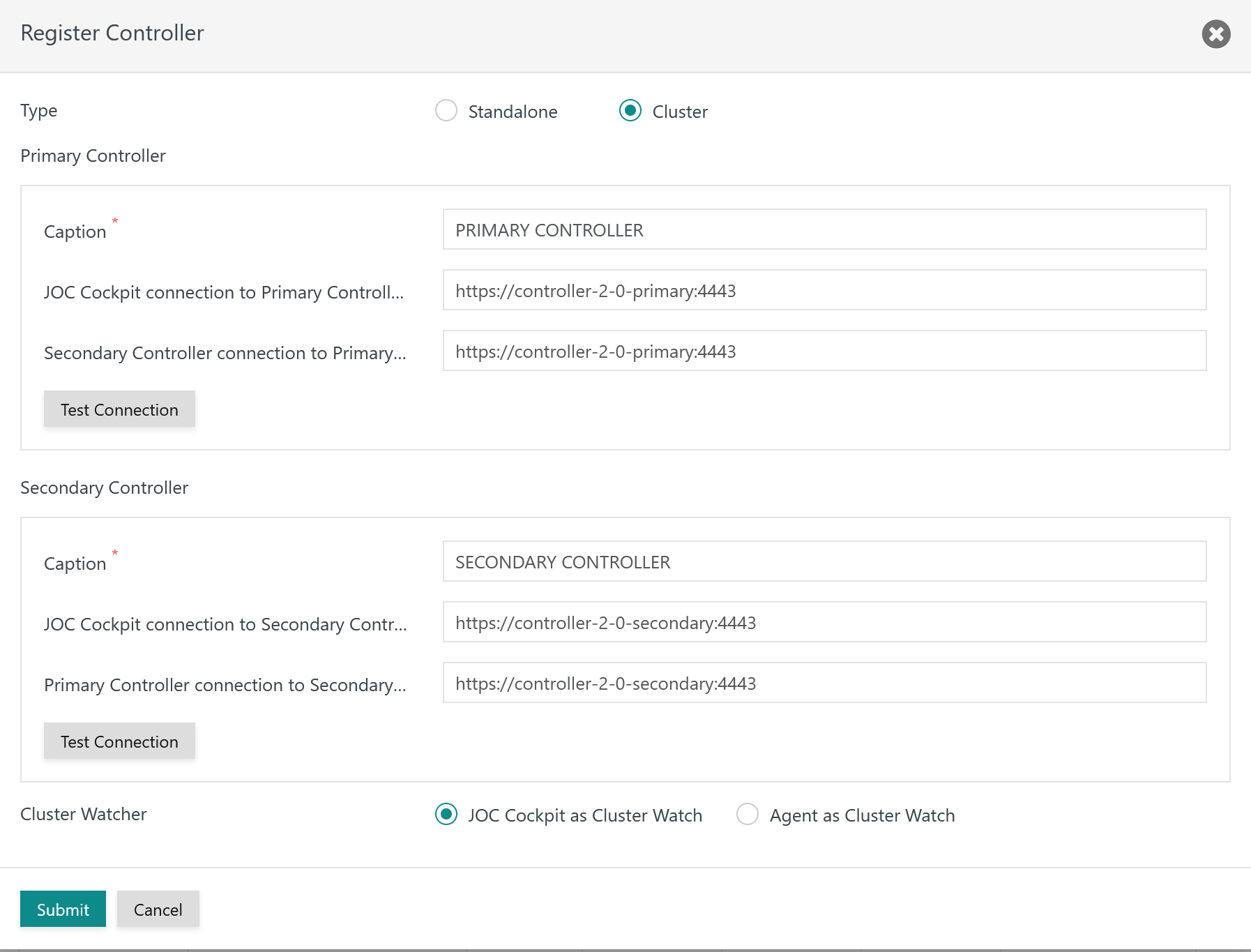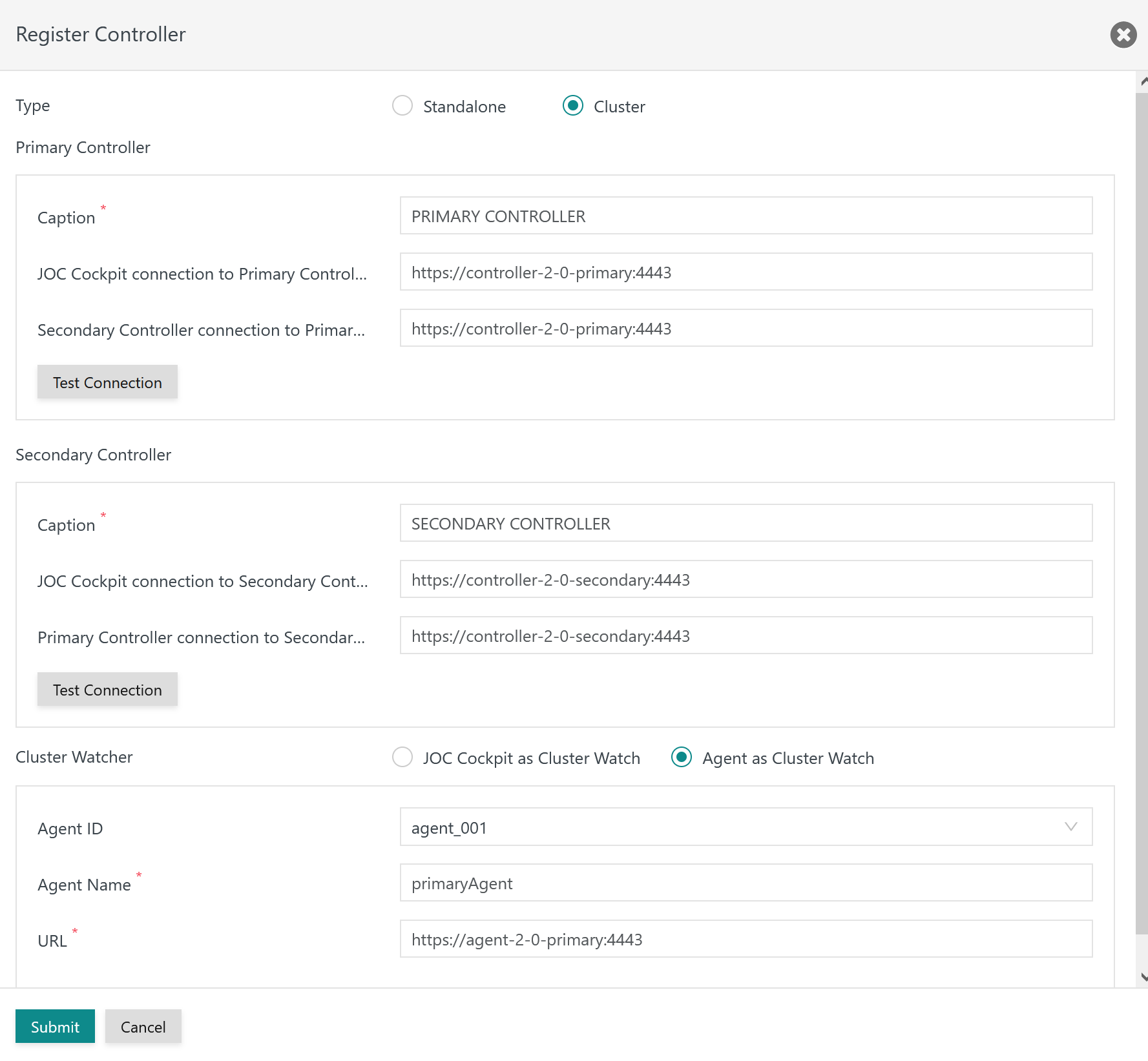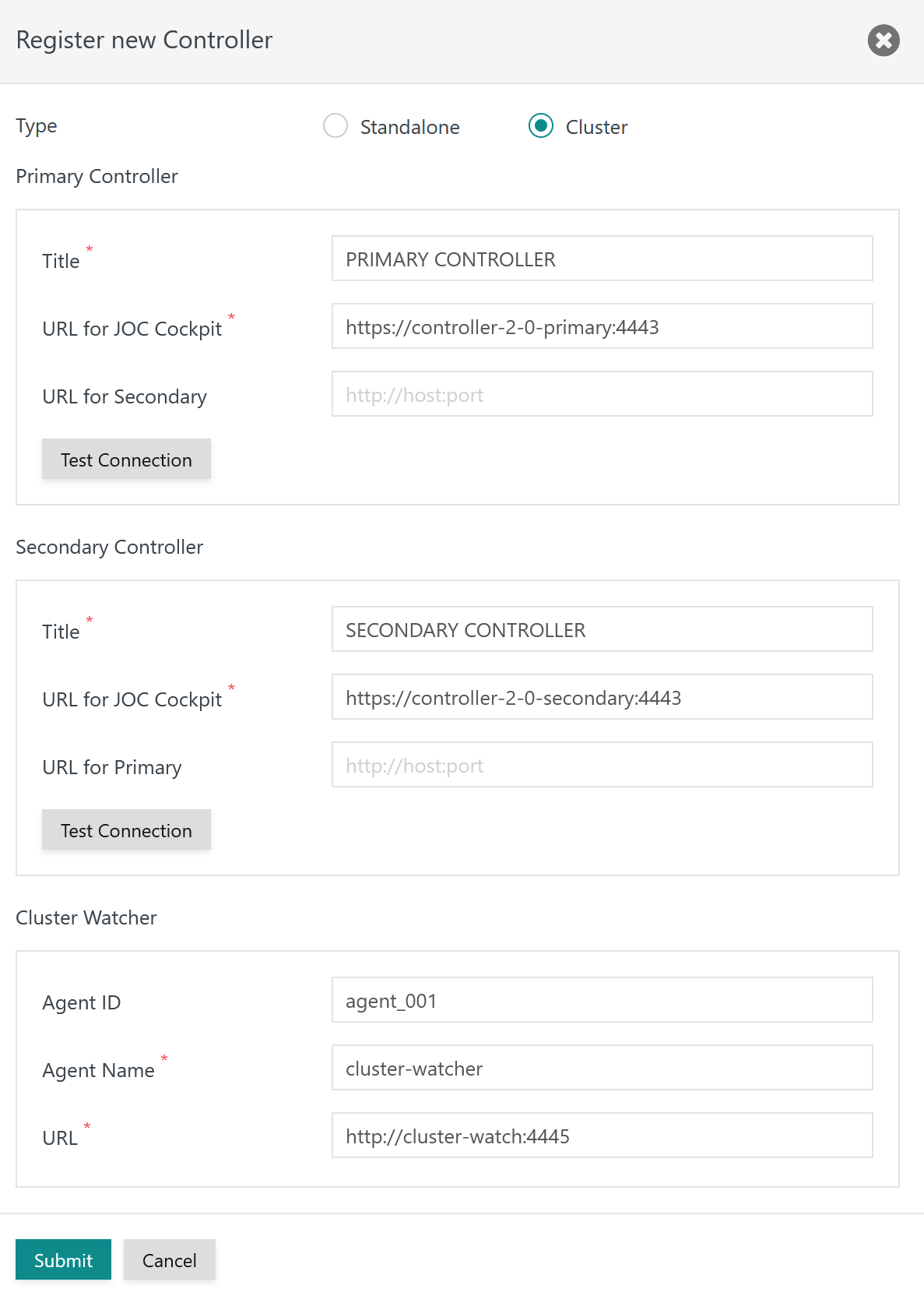Page History
...
Initial Operation is performed after installation of the JS7 Controller, Agent and the JOC Cockpit.
Operation Use of a Controller Cluster is subject to the agreements of the JS7 - License.
...
- Note that a Controller Cluster requires two Controller instances to be installed.
- For details see JS7 - Installation
- The steps for initial operation are the same for all supported platforms:
Controller Cluster Checks
...
- Unix: the Controller ID is specified with the
JS7_CONTROLLER_HOME/bin/controller_instance.shInstance Start Script - see the JS7 - Controller - Headless Installation on Linux /and Windows article. - Windows: the Controller ID is specified with the
JS7_CONTROLLER_HOME\bin\controller_instance.cmdInstance Start Script - see the JS7 - Controller - Installation Using the Windows Graphical Installer article.
...
Customers holding a commercial license receive a license key from SOS and can download the binary code that allows clustering of JS7 components products - see the JS7 - Download article for more information.
...
- Binary code for clustering is available from the
js7-license.jarfile, which can be obtained from JS7 - Download. - By downloading the binary code for clustering users consent with the license terms for a commercial license of JS7.
- The
js7-license.jarfile has to be stored to the following location:- Unix: Controller installation directory with
lib/user_libsub-directory:- Default location:
/opt/sos-berlin.com/js7/controller/lib/user_lib - If the
user_libsub-directory does not exist then users should create the sub-directory. - A different location for the installation directory can be specified during installation.
- Default location:
- Windows: Controller installation Directory with
lib\user_libsub-directory:- Default location:
C:\Program Files\sos-berlin.com\js7\controller\lib\user_lib - If the
user_libsub-directory does not exist then users should create the sub-directory. - A different location for the installation directory can be specified during installation.
- Default location:
- Unix: Controller installation directory with
Anchor license_key_docker license_key_docker
Handling for
| license_key_docker | |
| license_key_docker |
...
Container Installation
Basically the same locations for license key and licensed binary code apply as explained for Unix operating systems in previous sections of this article.
...
- The license key is added by storing the license certificate file in the following location:
/var/sos-berlin.com/js7/controller/config/license- The
/var/sos-berlin.com/js7/controllerdirectory is typically mounted from a Docker var volume when running the container, for details see the JS7 - Controller Installation for Docker Containers article.
Adding Licensed Binary Code
- Binary code for clustering is available from the
js7-license.jarfile, which can be obtained from the JS7 - Download page. - By downloading the binary code for clustering, users consent with the license terms for a commercial license of JS7.
- The
js7-license.jarfile has to be stored in the following location:/var/sos-berlin.com/js7/controller/config/lib- The
/var/sos-berlin.com/js7/controllerdirectory is typically mounted from a Docker avarvolume when running the container: for details see JS7 - Controller Installation for Docker Containers. - If the
config/libdsub sub-directory does not exist then you can create it before saving the thejs7-license.jarfile.
On start-up the Controller checks the above directory for the existence of the js7-license.jar file. If the file is found then:
...
A Controller Cluster implements high-availability for automated fail-over should a server node operating the Controller instance become unavailable.
A Controller Cluster requires an arbitrator to act as Cluster Watch. This role can be assigned JOC Cockpit or an Agent.
Controller Registration using JOC Cockpit as Cluster Watch
Starting from release 2.5.3 and 2.6.0 JOC Cockpit is always used as Cluster Watch, no additional options are offered:
Controller Registration using a Cluster Watch Agent
Starting from release 2.5.3 and 2.6.0 JOC Cockpit is always used as Cluster Watch, no additional options are offered:
This dialog allows the Primary Controller instance, the Secondary Controller instance and an Agent Cluster Watcher Watch to be specified.
Explanation
- Title: The title added for each Controller instance is displayed in the JS7 - Dashboard view.
- URL for JOC Cockpit: Primary and Secondary Controller instances are accessed from the JOC Cockpit using this URL.
- The URL includes the protocol, hostname and port that the relevant Controller instance is operated with.
- By default the HTTP protocol is used. The HTTPS protocol can be used if TLS/SSL certificates are in place, see the JS7 - Controller HTTPS Connections article.
- URL for Secondary / URL for Primary: The Primary Controller establishes a connection to the Secondary Controller and vice versa.
- Input to this field is not required if the URL for a Controller instance is the same across the network.
- Input to this field is required should Proxy Services be involved that make use of specific URLs.
- Cluster Watcher: An Watch: Either JOC Cockpit or an Agent is required for operation of a Controller Cluster. The Agent is
- If JOC Cockpit is assigned the Cluster Watch role then JOC Cockpit will contact both Controller Cluster members.
- If an Agent is used then it will be contacted by both Controller Cluster members to verify the cluster status
- .
- Agent ID: The Agent is assigned a unique identifier. Uniqueness is applied for all Agents registered with the same Controller. The Agent ID cannot be modified during the lifetime of an Agent. Changes to the Agent ID require the Agent to be removed and re-added with JOC Cockpit.
- Agent Name: The name of an Agent is used for example when assigning the Agent to jobs. Similarly to the Agent ID the Agent Name has to be unique but can be changed later on.
- Agent URL: The protocol HTTP or HTTPS, host name or IP address and port by which the Agent is accessible to the Controller.
- By default the HTTP protocol is used. The HTTPS protocol can be used if TLS/SSL certificates are in place, see JS7 - Agent HTTPS Connections.
Note: The following connections should be accessible and might require additional firewall rules to allow access to the relevant ports:
- JOC Cockpit connection
- to the Primary Controller's host and port.
- to the Secondary Controller's host and port.
- Primary Controller connection
- to the Secondary Controller's host and port.
- to the Cluster Watcher and any additional Agent's host and port.
- Secondary Controller connection
- to the Primary Controller's host and port.
- to the Cluster Watcher and any additional Agent's host and port.
For more information about network connections see JS7 - System Architecture.
...
This opens the following popup window:
Explanation:
- Agent ID: A unique identifier of the Agent. Uniqueness is applied for all Agents registered with the same Controller. This identifier cannot be changed later on.
- Agent Name: The name of an Agent is used, for example, when assigning the Agent to jobs. Similarly to the Agent ID,the Agent Name has to be unique but can be changed later on.
- Title: An individual description which can be searched for.
- Alias Names: The same Agent is available from a different name. This can be helpful if distinct Agent Names should be assigned the jobs, for example if more Agents are used in a production environment that map to a smaller number of Agents in a non-production environment.
- Process Limit: Agents can execute an unlimited number of parallel processes. Users can limit parallel processes to prevent exhausting a server's resources and to make orders wait until the next process will be available.
- URL: The HTTP or HTTPS protocol, host name or IP address and port with which the Agent can be accessed from the Controller.
...
- Installation
- Operation
- Configuration
...




